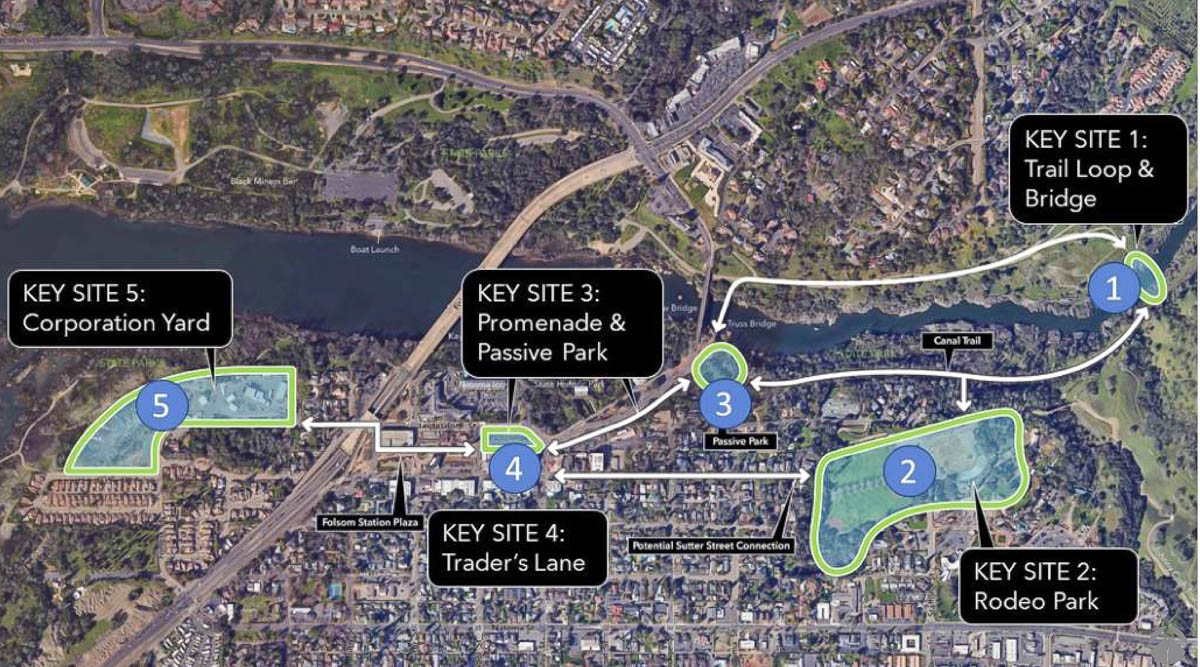The members of the Folsom City Council and those in attendance at City Hall had the opportunity for another review of the latest draft the 2024 River District Vision Plan earlier this week, setting a framework for the possibilities in th future development of the city’s iconic riverfront into a hub of recreation, culture, and economic growth.
Spanning over six miles along the American River and Lake Natoma, the River District encompasses a blend of public parks, historic landmarks, residential areas, and commercial zones. The Vision Plan details a framework to reimagine these spaces as hubs of activity for residents and visitors alike.
The recently released and revised Vision Plan draft reflects the results of a public outreach effort. Twenty-four Citizen Advisory Committee (CAC) members, representing various community groups, joined with city officials and design consultants to shape the plan. Their insights, combined with public surveys and workshops, emphasized priorities like expanded access to trails, recreational facilities, and historical preservation. The plan is divided into three geographical segments:
Northern Segment: Spanning from Folsom Lake Crossing to the Rainbow Bridge, this area could see enhancements to key attractions such as the Johnny Cash Trail, Folsom Zoo Sanctuary, and Rodeo Park.
Central Segment: Anchored by the Historic District and Powerhouse State Historic Park, this zone focuses on revitalizing Trader’s Lane, incorporating mixed-use developments, and improving pedestrian safety.
Southern Segment: The gateway to the district, this area could integrate recreational opportunities at Willow Creek and Alder Creek and improve connectivity to the city’s expanding trail network.
The Vision Plan focuses on enhancing public access, preserving environmental and cultural resources, and fostering community-focused economic opportunities. The plan identifies key projects and initiatives that could reshape Folsom’s relationship with its riverfront while respecting the area’s historical and ecological significance.
Expanded Details on Proposed Projects
The Vision Plan highlights five primary sites for development, each with unique features designed to address community needs, expand access, and create opportunities for economic and recreational growth. These projects represent a blend of conceptual ideas and future aspirations, requiring feasibility studies, environmental reviews, and funding strategies to bring them to life.
Canal Trail and Bridge: The proposed Canal Trail and Bridge project envisions an enhanced pedestrian and bicycle trail system designed to increase connectivity along the riverfront. The project could include the construction of new pedestrian bridges, creating seamless links between the Historic District, Lake Natoma, and surrounding neighborhoods. The upgraded trail network would cater to walkers, runners, and cyclists, ensuring safer and more accessible paths. These enhancements aim to create a continuous loop for recreational use while offering scenic views of the American River and Lake Natoma.
Potential benefits of the project include a reduction in vehicle traffic near recreational areas and the promotion of active, sustainable transportation. The project also proposes interpretive signage along trails to educate users about Folsom’s natural and cultural history.
Rodeo Park Upgrades: Rodeo Park, already a well-used community space, could be transformed into a multi-functional recreational hub. The Vision Plan includes proposals for upgrading sports fields, adding shaded picnic areas, and introducing modern playground equipment to enhance the park’s family-friendly appeal. The park’s trails and parking facilities could also see improvements, making it more accessible for a wider range of users.
Additional features may include event spaces that could host community gatherings, sports tournaments, or cultural celebrations. These upgrades are intended to make Rodeo Park a central destination for both residents and visitors while enhancing the area’s overall quality of life.
River Promenade: The River Promenade project proposes the creation of a vibrant, pedestrian-oriented corridor along the riverfront. This promenade could include paved pathways, seating areas, and landscaped zones to create a welcoming environment for walking, socializing, and enjoying the river views. Cultural elements such as art installations and interpretive exhibits could celebrate Folsom’s heritage, including its Native American history and Gold Rush roots.
The promenade is also designed to serve as a flexible event space, capable of hosting farmers markets, outdoor concerts, or seasonal festivals. Its integration with the Historic District could extend the visitor experience beyond Sutter Street, making the River District a more cohesive and attractive destination.
Trader’s Lane Redevelopment: The redevelopment of Trader’s Lane represents a key economic opportunity within the Vision Plan. This area, currently used for parking, could be transformed into a dynamic public plaza featuring boutique shops, restaurants, and gathering spaces. The redevelopment aims to preserve the Historic District’s charm while modernizing its infrastructure to better serve residents and attract tourists.
The Vision Plan highlights potential for mixed-use developments that could include retail on the ground floor with office or residential units above. This approach could diversify the area’s offerings while creating new revenue streams for the city. The proposed redevelopment also includes improved pedestrian access, enhancing connections between Trader’s Lane, the River Promenade, and other key sites in the district.
City Corporation Yard Redevelopment: The City Corporation Yard, a currently underutilized area, could be repurposed into a mixed-use development combining recreational, commercial, and cultural features. The Vision Plan envisions this site as a vibrant gathering place that may include a public market, boutique hotel, cultural facilities, and expanded recreational spaces. Proposed amenities also include picnic areas, walking trails, and viewpoints that capitalize on the site’s proximity to the river.
By incorporating a mix of uses, the redevelopment of the Corporation Yard could create a unique destination that appeals to a broad range of visitors. This project is also expected to generate significant economic benefits, aligning with the city’s goals for increased tourism and business activity in the River District.
Those that were not in attendance to Tuesday’s City Council meeting are encouraged to read the full River District Vision Plan Draft by just clicking here.
